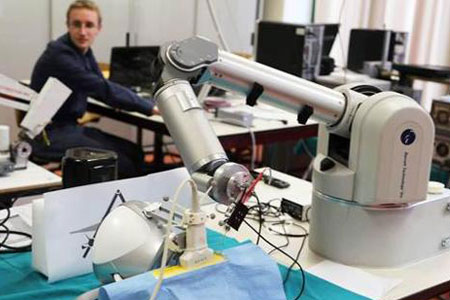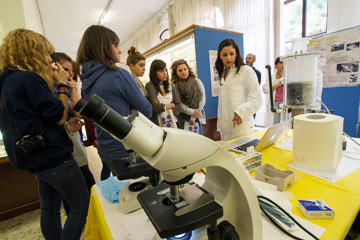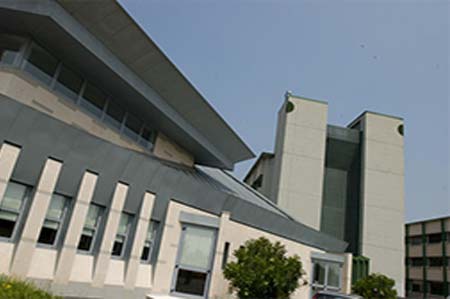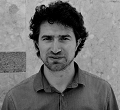|
Master in Computer game development
|
Fundamentals of human-computer interaction (2025/2026)
|
2
|
|
2
|
|
|
Laurea in Informatica [L-31]
Corso a esaurimento
|
Grafica al calcolatore (2025/2026)
|
6
|

|
4
|
(Teoria)
|
|
2
|
(Laboratorio)
|
|
Laurea magistrale in Artificial Intelligence
|
HCI - Multimodal Systems (2025/2026)
|
6
|

|
2
|
(Laboratory)
|
|
2
|
(Theory 2)
|
|
Laurea magistrale in Ingegneria e scienze informatiche
|
Programmazione grafica (2025/2026)
|
6
|

|
1
|
(Laboratorio)
|
|
5
|
(Teoria)
|
|
Master in Computer game development
|
Fundamentals of human-computer interaction (2024/2025)
|
2
|

|
2
|
|
|
Laurea in Informatica [L-31]
Corso a esaurimento
|
Grafica al calcolatore (2024/2025)
|
6
|

|
4
|
(Teoria)
|
|
2
|
(Laboratorio)
|
|
Laurea magistrale in Artificial Intelligence [LM-18]
Corso a esaurimento
|
HCI – Intelligent Interfaces (2024/2025)
|
6
|

|
2
|
(Theory)
|
|
2
|
(Laboratory)
|
|
Laurea magistrale in Ingegneria e scienze informatiche [LM-18/32]
Corso a esaurimento
|
Programmazione grafica (2024/2025)
|
6
|

|
5
|
(Teoria)
|
|
1
|
(Laboratorio)
|
|
Laurea magistrale in Computer Engineering for Robotics and Smart Industry
Corso a esaurimento
|
Computer vision (2023/2024)
|
6
|

|
1
|
(Laboratorio)
|
|
5
|
(Teoria)
|
|
Laurea magistrale in Ingegneria e scienze informatiche [LM-18/32]
Corso a esaurimento
|
Programmazione grafica (2023/2024)
|
6
|

|
1
|
(Laboratorio)
|
|
5
|
(Teoria)
|
|
Laurea magistrale in Computer Engineering for Robotics and Smart Industry
Corso a esaurimento
|
Robotics, Vision and Control (2023/2024)
|
6
|

|
3
|
VISION AND CONTROL
|
|
Laurea magistrale in Computer Engineering for Robotics and Smart Industry
Corso a esaurimento
|
Computer vision (2022/2023)
|
6
|

|
5
|
(Teoria)
|
|
1
|
(Laboratorio)
|
|
Laurea magistrale in Computer Engineering for Robotics and Smart Industry
Corso a esaurimento
|
Digital design (2022/2023)
|
6
|

|
3
|
|
|
Laurea magistrale in Ingegneria e scienze informatiche [LM-18/32]
Corso a esaurimento
|
Programmazione grafica (2022/2023)
|
6
|

|
1
|
(Laboratorio)
|
|
5
|
(Teoria)
|
|
Laurea magistrale in Computer Engineering for Robotics and Smart Industry
Corso a esaurimento
|
Robotics, Vision and Control (2022/2023)
|
6
|

|
3
|
VISION AND CONTROL
|
|
Laurea magistrale in Computer Engineering for Robotics and Smart Industry
Corso a esaurimento
|
Computer vision (2021/2022)
|
6
|

|
5
|
(Teoria)
|
|
1
|
(Laboratorio)
|
|
Laurea magistrale in Computer Engineering for Robotics and Smart Industry
Corso a esaurimento
|
Digital design (2021/2022)
|
6
|

|
3
|
|
|
Laurea magistrale in Ingegneria e scienze informatiche [LM-18/32]
Corso a esaurimento
|
Programmazione grafica (2021/2022)
|
6
|

|
1
|
(Laboratorio)
|
|
5
|
(Teoria)
|
|
Laurea magistrale in Computer Engineering for Robotics and Smart Industry
Corso a esaurimento
|
Robotics, vision and control (2021/2022)
|
6
|

|
3
|
VISION AND CONTROL
|
|
Laurea magistrale in Computer Engineering for Robotics and Smart Industry
Corso a esaurimento
|
Computer vision (2020/2021)
|
6
|

|
1
|
(Laboratorio)
|
|
5
|
(Teoria)
|
|
Laurea magistrale in Editoria e giornalismo [LM-19]
Corso a esaurimento
|
Informatica e produzione multimediale (m) (2020/2021)
|
12
|

|
2
|
II MODULO PARTE (P)
|
|
Laurea magistrale in Ingegneria e scienze informatiche [LM-18/32]
Corso a esaurimento
|
Programmazione grafica (2020/2021)
|
6
|

|
5
|
(Teoria)
|
|
1
|
(Laboratorio)
|
|
Laurea magistrale in Computer Engineering for Robotics and Smart Industry
Corso a esaurimento
|
Robotics, vision and control (2020/2021)
|
6
|

|
1
|
VISION AND CONTROL
|
|
Laurea magistrale in Ingegneria e scienze informatiche [LM-18/32]
Corso a esaurimento
|
Analisi di immagini e dati volumetrici (2019/2020)
|
6
|

|
5
|
(Teoria)
|
|
1
|
(Laboratorio)
|
|
Laurea magistrale in Editoria e giornalismo [LM-19]
Corso a esaurimento
|
Informatica e produzione multimediale (m) (2019/2020)
|
12
|

|
2
|
II MODULO PARTE (P)
|
|
Laurea magistrale in Ingegneria e scienze informatiche [LM-18/32]
Corso a esaurimento
|
Visione computazionale (2019/2020)
|
6
|

|
5
|
(Teoria)
|
|
1
|
(Laboratorio)
|
|
Laurea magistrale in Editoria e giornalismo [LM-19]
Corso a esaurimento
|
Informatica e produzione multimediale (m) (2018/2019)
|
12
|

|
2
|
II MODULO PARTE (P)
|
|
Laurea magistrale in Ingegneria e scienze informatiche [LM-18/32]
Corso a esaurimento
|
Interazione uomo macchina (2018/2019)
|
6
|

|
4
|
(Teoria)
|
|
2
|
(Laboratorio)
|
|
Laurea magistrale in Ingegneria e scienze informatiche [LM-18/32]
Corso a esaurimento
|
Visione computazionale (2018/2019)
|
6
|

|
5
|
(Teoria)
|
|
1
|
(Laboratorio)
|
|
Master in Computer game development
|
Fundamentals of human-computer interaction (2017/2018)
|
2
|
|
2
|
|
|
Laurea magistrale in Editoria e giornalismo [LM-19]
Corso a esaurimento
|
Informatica e produzione multimediale (m) (2017/2018)
|
12
|

|
6
|
II MODULO PARTE (P)
|
|
6
|
I MODULO PARTE (I)
|
|
Laurea magistrale in Ingegneria e scienze informatiche [LM-18/32]
Corso a esaurimento
|
Visione computazionale (2017/2018)
|
6
|

|
6
|
|
|
Laurea magistrale in Editoria e giornalismo [LM-19]
Corso a esaurimento
|
Informatica e produzione multimediale (m) (2016/2017)
|
12
|

|
6
|
I MODULO PARTE (I)
|
|
6
|
II MODULO PARTE (P)
|
|
Laurea magistrale in Ingegneria e scienze informatiche [LM-18/32]
Corso a esaurimento
|
Visione computazionale (2016/2017)
|
6
|

|
6
|
|
|
Laurea magistrale in Editoria e giornalismo [LM-19]
Corso a esaurimento
|
Informatica e produzione multimediale (m) (2015/2016)
|
12
|
|
6
|
II MODULO PARTE (P)
|
|
6
|
I MODULO PARTE (I)
|
|
Laurea magistrale in Ingegneria e scienze informatiche [LM-18/32]
Corso a esaurimento
|
Visione computazionale (2015/2016)
|
6
|
|
6
|
|
|
Laurea magistrale in Editoria e giornalismo [LM-19]
Corso a esaurimento
|
Informatica e produzione multimediale (m) (2014/2015)
|
12
|
|
6
|
II MODULO PARTE (P)
|
|
6
|
I MODULO PARTE (I)
|
|
Laurea magistrale in Ingegneria e scienze informatiche [LM-18/32]
Corso a esaurimento
|
Visione computazionale (2014/2015)
|
6
|
|
6
|
|
|
Laurea magistrale in Editoria e giornalismo [LM-19]
Corso a esaurimento
|
Informatica e produzione multimediale (m) (2013/2014)
|
12
|
|
6
|
II MODULO PARTE (P)
|
|
6
|
I MODULO PARTE (I)
|
|
Laurea magistrale in Mathematics [LM-40]
Corso a esaurimento
|
Mathematical methods in image processing and shape analysis (seminar course) (2013/2014)
|
6
|
|
1
|
|
|
Laurea magistrale in Ingegneria e scienze informatiche [LM-18/32]
Corso a esaurimento
|
Visione computazionale (2013/2014)
|
6
|
|
6
|
|
|
Laurea magistrale in Editoria e giornalismo [LM-19]
Corso a esaurimento
|
Informatica e produzione multimediale (m) (2012/2013)
|
12
|
|
6
|
II MODULO PARTE (P)
|
|
6
|
I MODULO PARTE (I)
|
|
Laurea magistrale in Ingegneria e scienze informatiche [LM-18/32]
Corso a esaurimento
|
Visione computazionale (2012/2013)
|
6
|
|
6
|
|
|
Laurea magistrale in Editoria e giornalismo [LM-19]
Corso a esaurimento
|
Informatica e produzione multimediale (m) (2011/2012)
|
12
|
|
6
|
II MODULO PARTE (P)
|
|
6
|
I MODULO PARTE (I)
|
|
Laurea magistrale in Editoria e giornalismo [LM-19]
Corso a esaurimento
|
Informatica e produzione multimediale (m) (2010/2011)
|
12
|
|
6
|
I MODULO PARTE (I)
|
|
6
|
II MODULO PARTE (P)
|
|
Master in Computer game development
|
Fundamentals of Interaction Design (2009/2010)
|
4
|
|
4
|
|
|
Laurea magistrale in Editoria e giornalismo [LM-19]
Corso a esaurimento
|
Informatica e produzione multimediale (m) (2009/2010)
|
12
|
|
6
|
I MODULO PARTE (I)
|
|
6
|
II MODULO PARTE (P)
|
|
Laurea magistrale in Ingegneria e scienze informatiche [LM-18/32]
Corso a esaurimento
|
Interazione uomo macchina (2009/2010)
|
6
|
|
6
|
|
|
Laurea magistrale in Discipline artistiche e archeologiche
|
Informatica per i beni culturali (m) (2008/2009)
|
6
|
|
6
|
|
|
Laurea specialistica in Editoria e comunicazione multimediale - Ordinamento fino all'a.a. 2007/2008
Corso disattivato
|
Progettazione e produzione multimediale (s) (2008/2009)
|
6
|
|
6
|
|
|
Laurea specialistica in Editoria e comunicazione multimediale - Ordinamento fino all'a.a. 2007/2008
Corso disattivato
|
Informatica multimediale (s) (2007/2008)
|
6
|
|
6
|
|
|
Laurea specialistica in Editoria e comunicazione multimediale - Ordinamento fino all'a.a. 2007/2008
Corso disattivato
|
Progettazione e produzione multimediale (s) (2007/2008)
|
6
|
|
6
|
|
|
Laurea specialistica in Editoria e comunicazione multimediale - Ordinamento fino all'a.a. 2007/2008
Corso disattivato
|
Informatica multimediale (s) (2006/2007)
|
6
|
|
6
|
|
|
Laurea specialistica in Editoria e comunicazione multimediale - Ordinamento fino all'a.a. 2007/2008
Corso disattivato
|
Progettazione e produzione multimediale (s) (2006/2007)
|
6
|
|
6
|
|
|
Laurea specialistica in Editoria e comunicazione multimediale - Ordinamento fino all'a.a. 2007/2008
Corso disattivato
|
Informatica multimediale (s) (2005/2006)
|
6
|
|
6
|
|
|
Laurea specialistica in Editoria e comunicazione multimediale - Ordinamento fino all'a.a. 2007/2008
Corso disattivato
|
Progettazione e produzione multimediale (s) (2005/2006)
|
6
|
|
6
|
|
|
Laurea specialistica in Giornalismo - Ordinamento fino all'a.a. 2007/2008
Corso disattivato
|
Strumenti informatici per giornalisti (s) (2005/2006)
|
6
|
|
6
|
|
|
Laurea in Scienze della comunicazione: editoria e giornalismo - ordinamento fino all'a.a. 2007/2008
|
Informatica di base (i) (2004/2005)
|
6
|
|
|
|
|
Laurea in Lettere (ordinamento fino all'A.A. 2007/08)
|
Informatica di base (i) (2004/2005)
|
3
|
|
|
|
|
Laurea specialistica in Editoria e comunicazione multimediale - Ordinamento fino all'a.a. 2007/2008
Corso disattivato
|
Informatica multimediale (s) (2004/2005)
|
6
|
|
|
|








 castellani
castellani univr
univr
